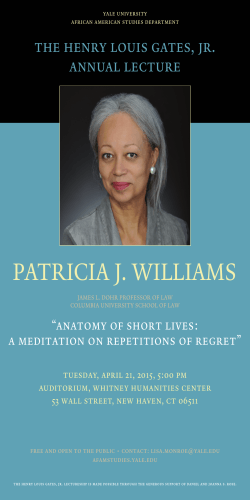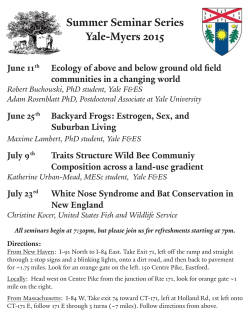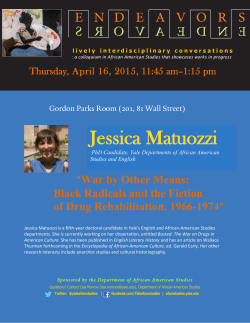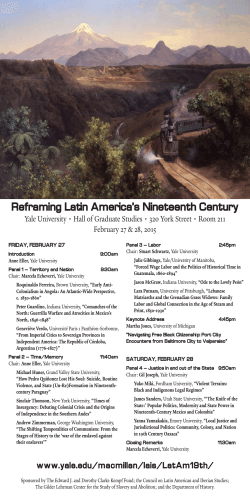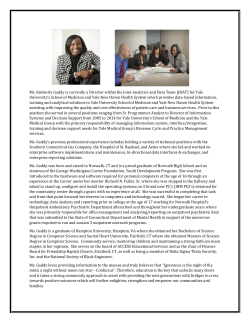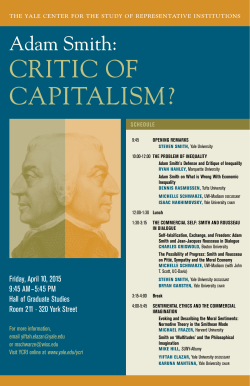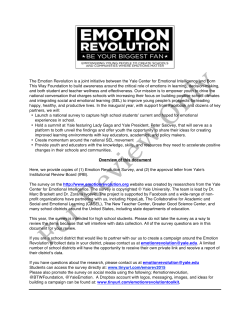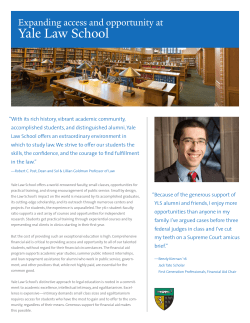
Expanding Access to Yale College - Giving to Yale
Expanding Access to Yale College Dear Friends, “This is how we should value our students.” Teaching at Yale University, as I did for three decades, is an exhilarating experience. In daily interactions with our remarkable students, I was energized by their intellectual curiosity, insight, and adventurousness. As my colleagues can attest, it is a privilege to help these young people prepare for lives of leadership and service after graduation. The competition to be part of this select body is intense. We received a record 30,931 applications for the Class of 2018, and the resulting cohort of 1,361 freshmen is as talented as any as we have seen. These students represent all fifty states, the District of Columbia, Puerto Rico, Guam, and fifty-six foreign countries. They also come from diverse economic and social backgrounds— for us a defining strength, made possible by Yale’s financial aid program. Support for students has a long tradition at Yale, which established its first scholarship fund in 1733. In 1964, we became the first private research university in the nation to adopt need-blind admissions—a policy of evaluating applicants on merit alone—backed by our promise to meet their full demonstrated need for financial aid. In the fifty years since, the university has worked to improve this program to best support our students and their families. Now we aim to do more. Access Yale is an initiative to further build our financial aid resources, open new doors for under-served populations, and lay the groundwork for an expanded Yale College. Together, these e≠orts send a vital message—that if we value our students and the contributions they make to society, we must provide them every opportunity for learning and advancement. I invite you to join in this important initiative. Your support can make a tremendous di≠erence in the lives of today’s brightest young people, by keeping Yale’s superlative education a≠ordable and accessible to students from every background. Sincerely, Peter Salovey ’86 Ph.D. President, Yale University What is Access Yale? For fifty years, financial aid policies in Yale College have aimed to place a world-class education within reach of all qualified students, regardless of their financial means—an ideal that ensures on our campus a broad representation of people and perspectives. It is a feature that defines the Yale experience for those who teach and study here, and it raises our reputation for excellence worldwide. In support of this tradition, Access Yale is a two-year initiative to raise $200 million in new funding for financial aid. An inclusive undertaking, the initiative extends to Yale College, the Graduate School, and the twelve professional schools. By securing current use funding and new endowment, Access Yale aims to increase opportunities for young people, make our educational o≠erings more competitive, and free up operating funds for our core mission of teaching and research. We also aim to support a 15 percent expansion of the undergraduate student body, the first since the admission of women to Yale College in 1969. Expand access for the most talented students Yale University is widely known— and widely sought—for its strength in undergraduate education. Students come here from around the world to study in programs that span the social sciences, the arts, humanities, and natural science, all supported by a world-class faculty and a signature residential college system. Access Yale a∞rms and extends our best e≠orts to keep this peerless education open to all students. Since 2008, our financial aid policies have been enhanced to ensure that no student is required to take out loans to pay for a Yale education, and families with less than $65,000 in annual income are not asked to make any financial contribution. Fourteen percent of the Class of 2018 will be the first in their families to graduate from a four-year college or university, and 16 percent of American students in the class received a federal Pell grant for lowincome college students. In keeping with its commitment to enroll students from all economic backgrounds, Yale is also expanding its involvement with the QuestBridge National College Match, a program that helps high-achieving, lowincome students gain admission to selective colleges. Since 2007, Yale has traditionally enrolled fifty to sixty Questbridge finalists in each freshman class and now aims to increase this number by 50 percent. For the Class of 2018, Yale enrolled eighty Questbridge finalists, and another seventy-five to eighty are expected to enroll in the Class of 2019. In addition, Yale is continuing to step up recruitment among firstgeneration college aspirants and under-resourced high schools where young people may not know that Yale is an a≠ordable option. For these students, we provide support that includes financial aid and more—a bridge program to highlight Yale’s academic culture and resources, plus advising, mentoring, and tutoring programs in both the sciences and humanities. Generous funding of these enhancements will ensure that admitted students find the resources they need to succeed once they get here. Support a larger student body Close the funding gap Ten years ago, Yale College was already among the nation’s most selective programs, admitting only 9.9 percent of applicants for the Class of 2008. This year, with 30,931 applying for about 1,300 openings in the Class of 2018, Yale admitted just 6.3 percent. Our applicant pool stands among the nation’s strongest; clearly, we have the potential to admit an even greater number of highly qualified applicants. Now, Yale plans expand its under graduate enrollment, adding some 200 students per class. In 2017, the university will open two new residential colleges to accommodate these students, who are also expected to need financial Access Yale aims to build new scholarship resources to keep pace with the growing needs of students and their families. Currently, 50 percent of undergraduate students receive financial aid, with an average award of $42,440 per year. Shortly after Yale announced its new financial aid policy in 2008, the endowment su≠ered a precipitous decline of some 25 percent, reducing the annual payout for scholarships just as student need was trending upward. This combination of events opened a gap in the funding stream for student aid, which persists even though the endowment has recovered lost ground. In fiscal 2008–2009, the payout aid at the same levels as the larger student body. By 2021, when the new residential colleges are fully populated, the university will spend an estimated $18 million per year beyond today’s budget levels to cover their additional scholarship needs. supplied a generous 79 percent of the $88 million slated for undergraduate financial aid. But in 2014–2015, the payout is funding just 56 percent of a $116.6 million financial aid budget, with the balance coming from annual giving and general operating funds. Without new additions to the endowment, Yale expects a continuing gap between its funding needs and the endowment payout. Building Yale’s scholarship resources to close this gap is a foremost priority. By directing gifts to endowed funds and current use scholarships, donors can make a lasting contribution that secures access to a Yale education in any economic climate, today and well into the future. A tradition of student support Milestones in financial aid Financial aid today 1733 1964 5,450 $59,800 The Reverend George Berkeley established the Berkeley Scholarships for graduate study, the first such scholarships in America. Yale became the first research university to introduce need-blind admission for undergraduates. At the same time, Yale committed itself to meet the demonstrated financial need of all admitted students. Total students in Yale College Total cost of attending Yale College (tuition, room, board) 1920s A bequest from John W. Sterling b.a. 1864 was directed to endowment funding for financial aid. Today the Sterling Scholarship Fund provides scholarships for more than one hundred undergraduates each year. 50 Percentage of students receiving aid 1823 Yale College created its first scholarship fund, thanks to a gift from David C. DeForest for the “education of young men in indigent circumstances and of good talents.” Grants from the DeForest fund were awarded starting in 1852. 2001 Need-blind admission was extended to international students. $116.6 million Financial aid budget for 2014–2015, Yale College 2008 Yale introduced further enhancements to its financial aid program, easing demands on families’ assets, extending benefits to a greater number of students, and increasing levels of support for those who qualify. The changes resulted in the largest increase in spending for financial aid in the history of the university. In fiscal 2008–2009, the first year of the enhanced financial aid policy, the percentage of Yale College students receiving financial aid jumped from 43 percent to 52 percent. $340 million Financial aid budget for 2014–2015, university $42,440 Average Yale grant per undergraduate student recipient Supporting Access Yale Throughout its history, Yale has made financial aid a priority, with the valued support of friends and alumni. Yale College has established one of the nation’s most generous need-based financial aid programs. The Access Yale initiative seeks to build the financial aid endowments in Yale College, the Graduate School of Arts and Sciences, and the professional schools. It also aims to raise current use funds that can go to work immediately to support financial aid across the campus, helping to keep Yale a≠ordable for students of all socioeconomic backgrounds. In 2014–2015, Yale budgeted $340 million to support financial aid university-wide. A growing financial aid endowment can ensure that su∞cient resources are available year after year, relieving pressure on the general operating budget. What counts? Access Yale will count contributions made between July 1, 2014, and June 30, 2016, including: •Gifts and new pledges in support of financial aid •Planned gifts and documented bequests designated for financial aid •Financial aid gifts directed to Yale’s endowment •Current use funds, including all annual gifts directed to financial aid and to unrestricted current use To learn more There are many ways of giving to Access Yale. For more information, please contact your gift o∞cer. Our sta≠ directory may be found at giving.yale.edu/key-contacts. You may also call or email: Martha M. Woodcock Director of Development for Yale College 203.432.9067 [email protected] Photo credits: Cover: Lisa Kereszi Page 2: Katie Smith Pages 4–5: Michael Marsland Pages 6–7: Lisa Kereszi Page 11: Michael Marsland 03/15 Design: Yve Ludwig
© Copyright 2025

